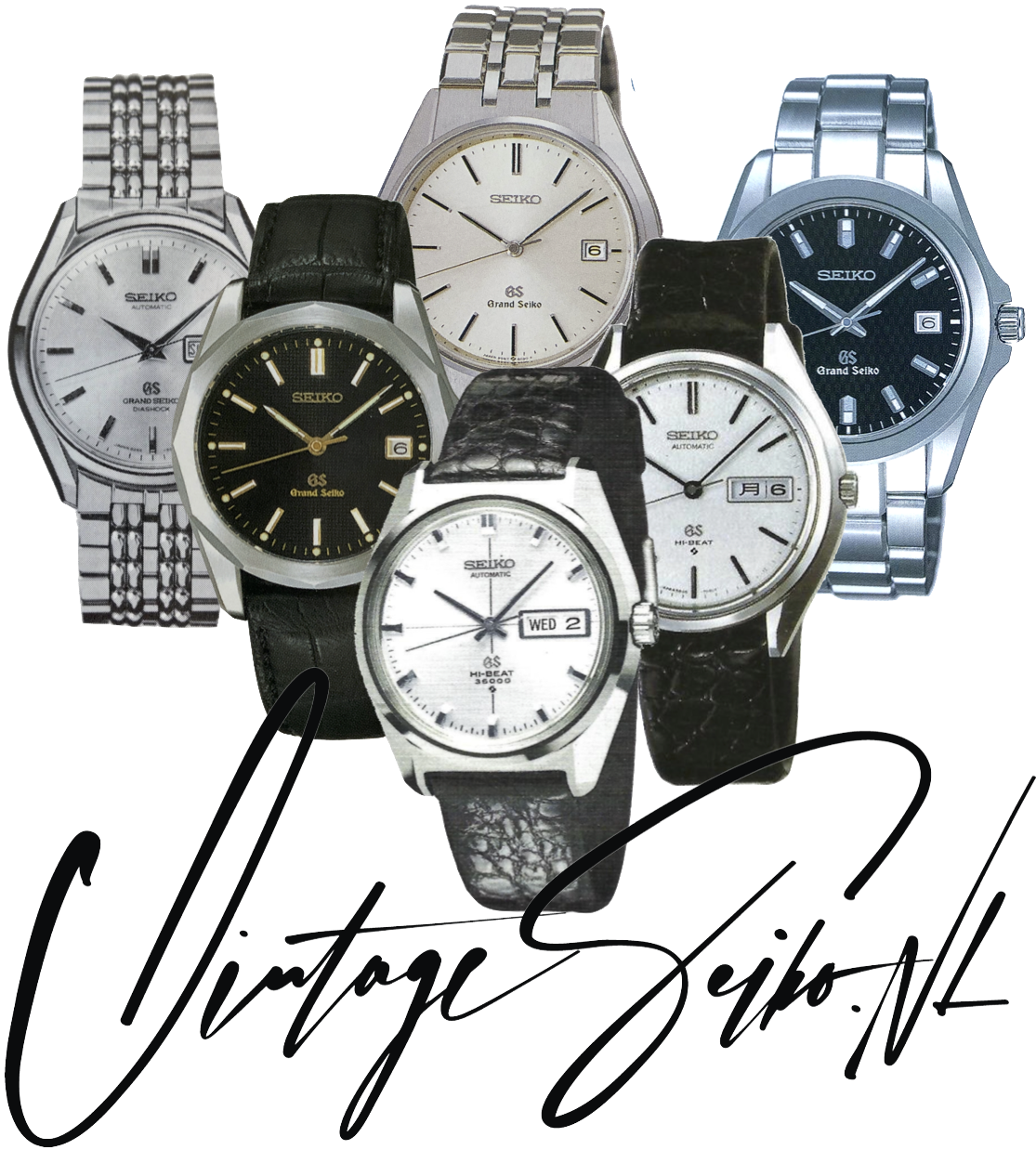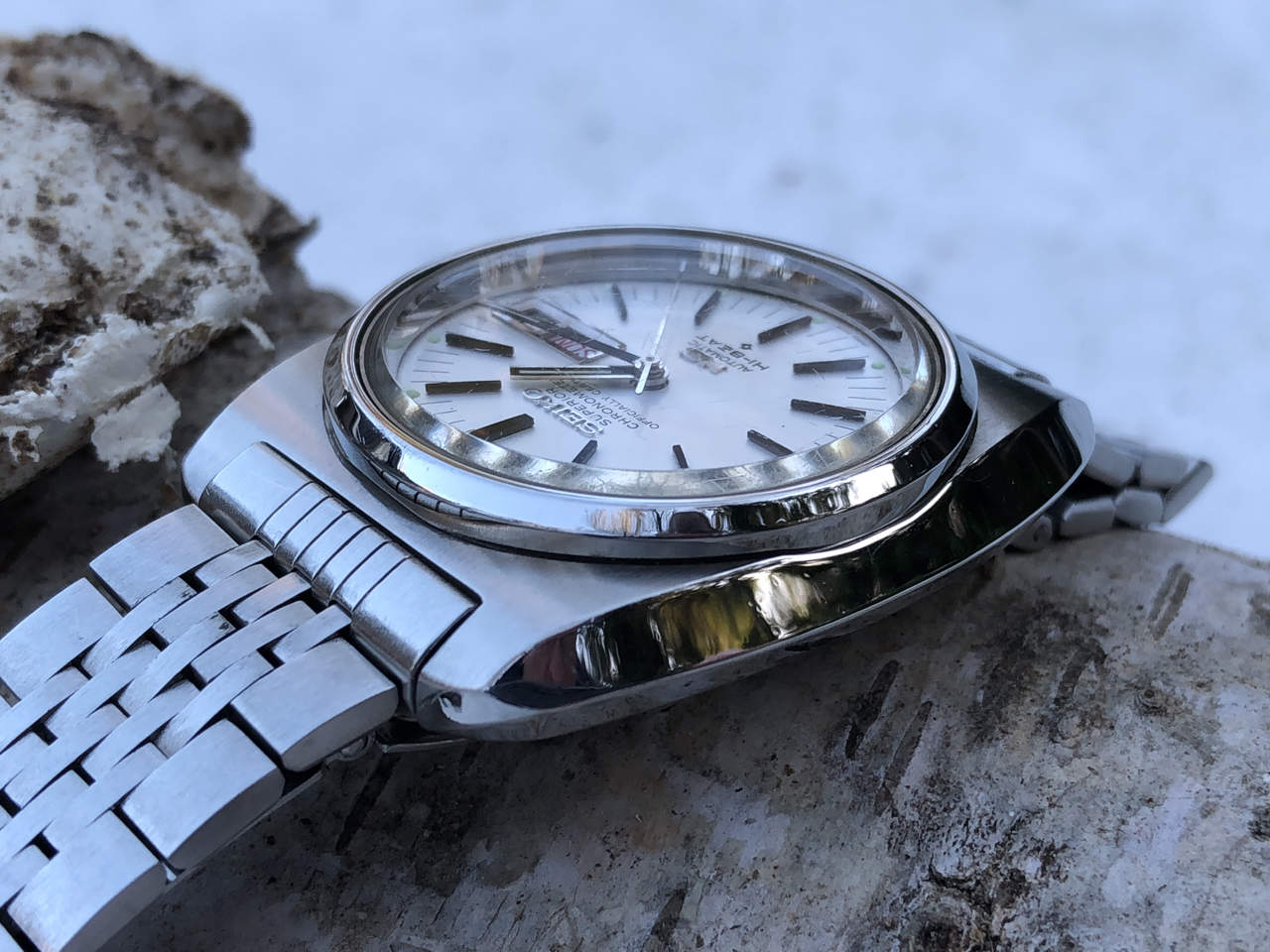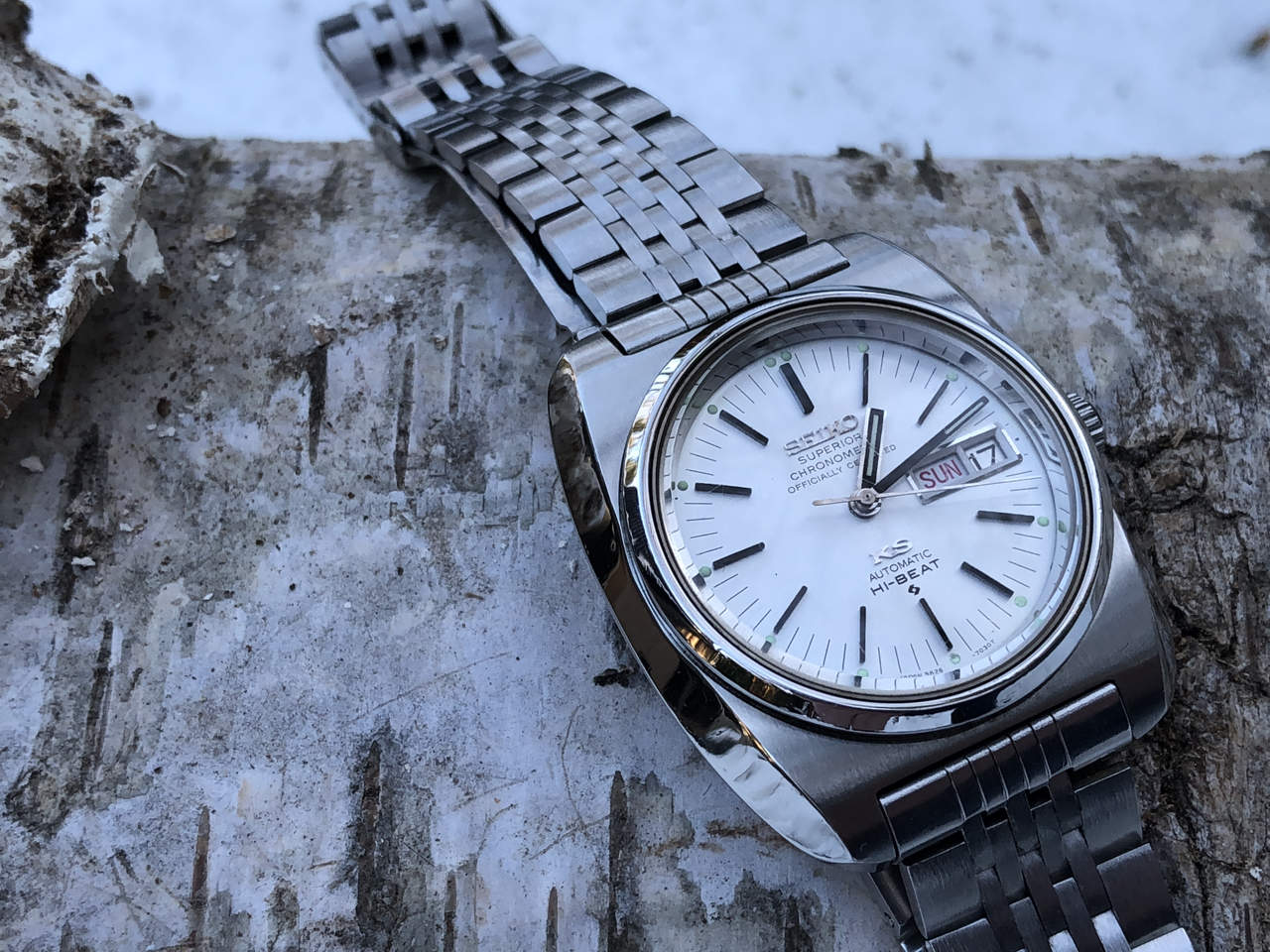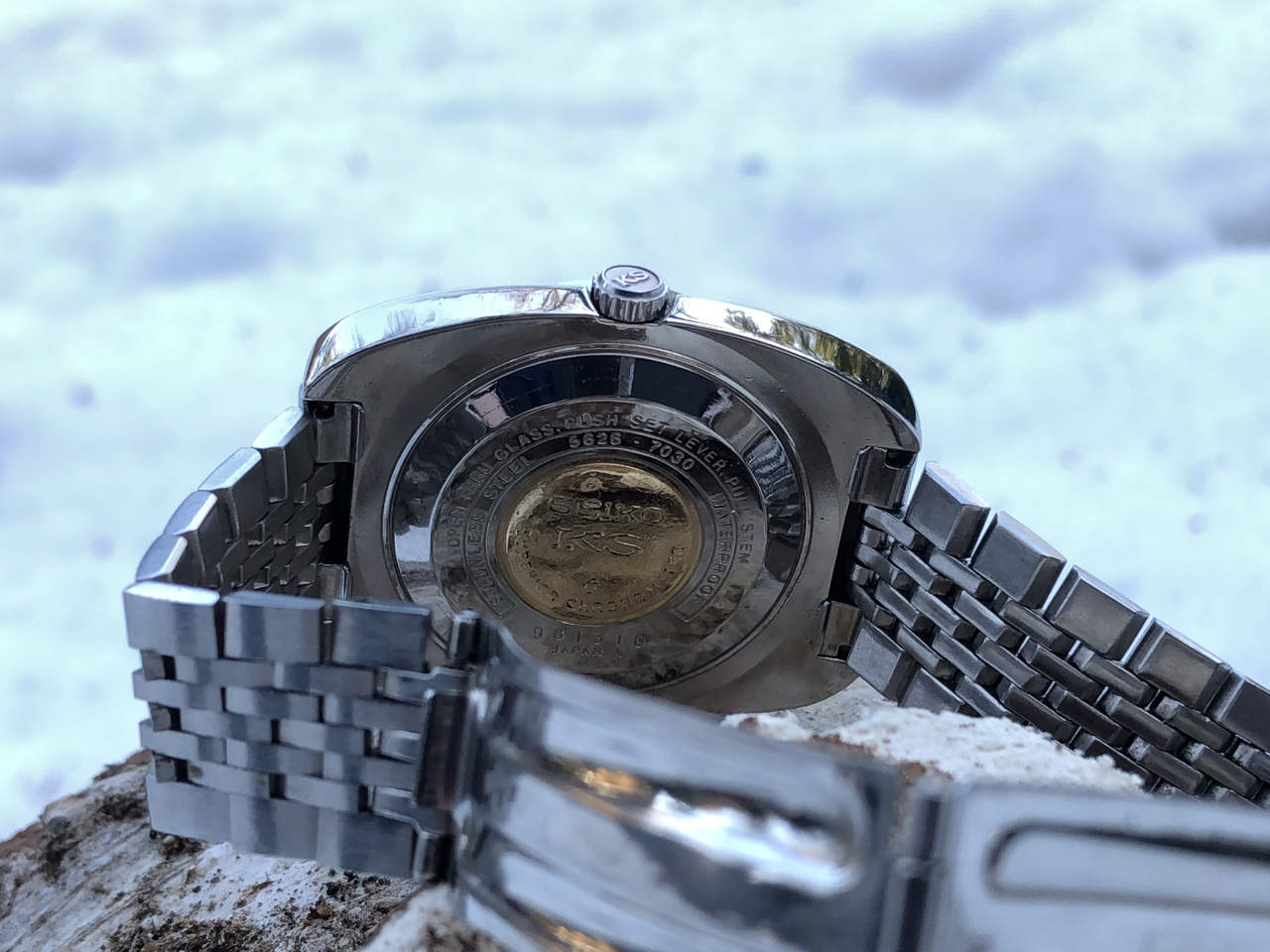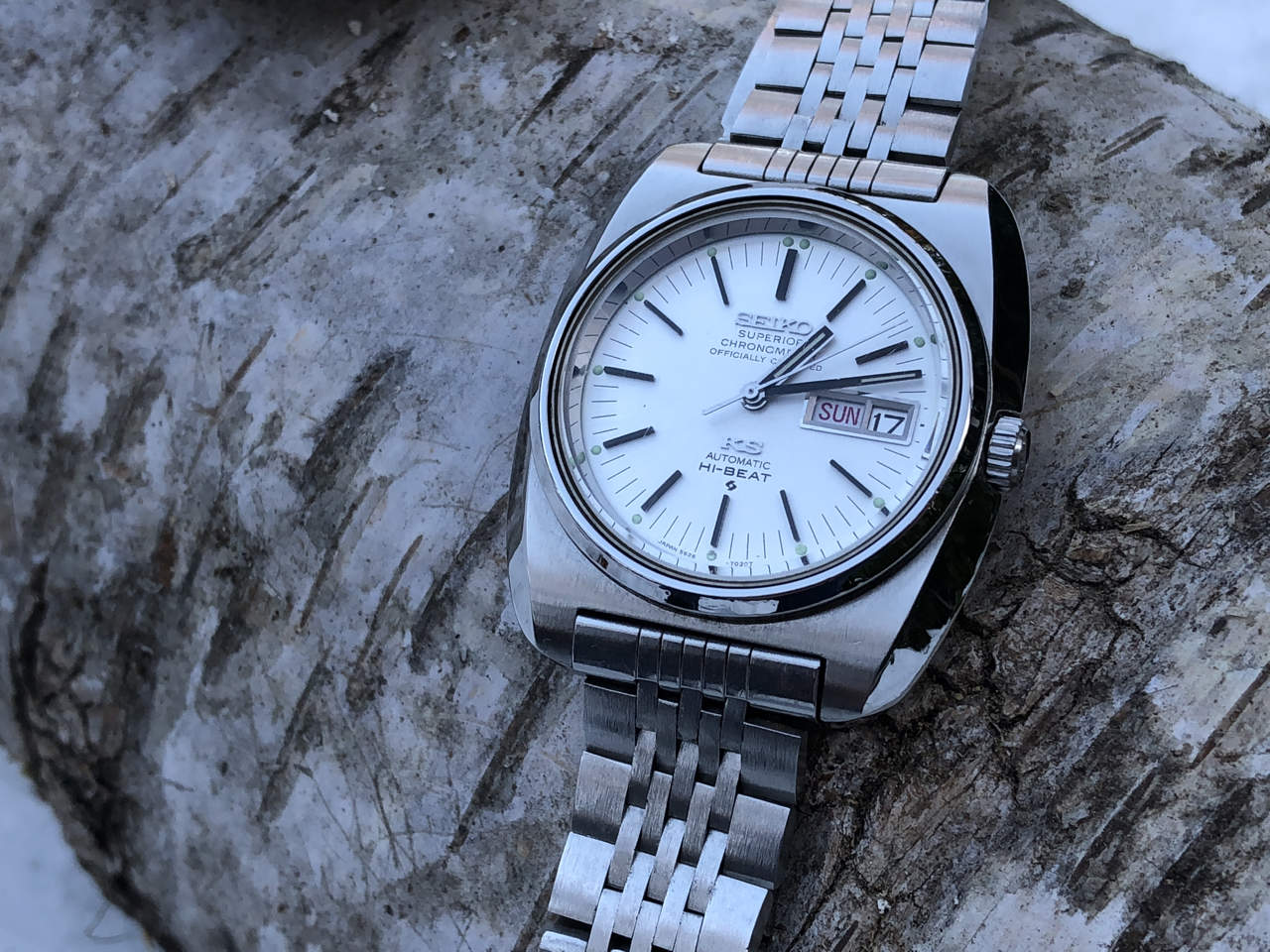
King Seiko Superior Chronometer 5626-7030 (sold)
€ 680.00
Sold out
Category
King Seiko
Tags
1969
Automatic
Dress
Excellent
King Seiko
Sold
Steel
White
It is a rare occasion to come across a well preserved 1969 King Seiko superior Chronometer. This one has a rare case design to boot and comes with a full size original bracelet! On the back there is the golden seal, on the photo it is shiny because of a protective sticker..
This watch has been well taken care of in the past and we are confident it will keep on ticking for the next fifty years.
Now for some background information... At some time in the sixties Taro Tanaka, Seiko’s first hired graduate of a College Design Program, came up with design rules which eventually came to be known as the “Grammar of Design” at Seiko. He wanted Grand Seiko and King Seiko watches to sparkle brilliantly when on display and without any distortions.

The rules were simplicity itself:
1. Perfectly flat surfaces and angles for cases, dials, hands, indexes
2. Two Dimensional faceted curves for the bezel
3. All distortion should be eliminated from the dial, hands, indexes and case, the finishing of the dial and case should be a mirror finish so it shines and sparkles
4. No more round cases, a unique case design
Only Grand and King Seiko watches benefited from this design as the new case design required very expensive and labour intensive polishing and finishing. Those looking for the most valuable GS watch should look no further than “The Grammar of Design” (44GS). This is the model that’s most remembered when talking about the Grand Seiko line. The watch’s design is even called the “Grand Seiko Style”,
Those looking for the most valuable King Seiko should look for a mid to late sixties Daini or Suwa release like the King Seiko 5626-7000. (Case and dial design sparkling from all angles). In all its aspects Tanaka’s design is so iconic that all Seiko products that were released afterward emulated it.
The Seals…
The Daini designs never had gold seals, and only the original 5246-6000, 5246-6010 and 5246-6020 had one-piece cases, while the later 5246-7000, 5256-8000 and 5256-8010 had screw-backs. There is the 5246-6020, a cushion-type case and the 5256-8000, lugless with a bracelet. The 5246-7000 has a faceted crystal and dark-coloured dial, and the 5246-6000 has its brushed, convex lugs.
The 5246-6010 and the 5256-8010 have the most classic design aesthetic adhering to Tanaka’s grammar of design so prominent in the 562x series.
The Suwa King Seikos then, with seals, were produced actually for a rather short period, until 1972. One can usually identify original seals from good photographs. One clue is the boundary between the edge of the seal and the case – the original seals have a narrow, flat margin that sits slightly lower than the edge of the recess in the case and without any gap visible.
Interestingly, there is some lug variation in individual examples of these watches in the relative width of the side surfaces and of the very narrow flat surfaces on the inside top that does not appear to be due to refinishing. Also, in 1971 Seiko undertook a major redesign of the case and dial of the “standard” KS 5626-7000 pictured above, resulting in the 5626-7110.
The ultimate King Seiko
For many people the best King Seiko is labeled chronometer. Later production runs of the 5626-7040 chronometer, while keeping the monobloc case designs and case numbers, lost the Seal, substituting an engraved “KS” roundel instead. Pity the poor Japanese businessman, who, probably sometime in 1972, was gifted a later example 5626-7040 as a retirement present and discovered that it lacked the coveted gold medallion!
This watch has been well taken care of in the past and we are confident it will keep on ticking for the next fifty years.
Now for some background information... At some time in the sixties Taro Tanaka, Seiko’s first hired graduate of a College Design Program, came up with design rules which eventually came to be known as the “Grammar of Design” at Seiko. He wanted Grand Seiko and King Seiko watches to sparkle brilliantly when on display and without any distortions.
The rules were simplicity itself:
1. Perfectly flat surfaces and angles for cases, dials, hands, indexes
2. Two Dimensional faceted curves for the bezel
3. All distortion should be eliminated from the dial, hands, indexes and case, the finishing of the dial and case should be a mirror finish so it shines and sparkles
4. No more round cases, a unique case design
Only Grand and King Seiko watches benefited from this design as the new case design required very expensive and labour intensive polishing and finishing. Those looking for the most valuable GS watch should look no further than “The Grammar of Design” (44GS). This is the model that’s most remembered when talking about the Grand Seiko line. The watch’s design is even called the “Grand Seiko Style”,
Those looking for the most valuable King Seiko should look for a mid to late sixties Daini or Suwa release like the King Seiko 5626-7000. (Case and dial design sparkling from all angles). In all its aspects Tanaka’s design is so iconic that all Seiko products that were released afterward emulated it.
The Seals…
The Daini designs never had gold seals, and only the original 5246-6000, 5246-6010 and 5246-6020 had one-piece cases, while the later 5246-7000, 5256-8000 and 5256-8010 had screw-backs. There is the 5246-6020, a cushion-type case and the 5256-8000, lugless with a bracelet. The 5246-7000 has a faceted crystal and dark-coloured dial, and the 5246-6000 has its brushed, convex lugs.
The 5246-6010 and the 5256-8010 have the most classic design aesthetic adhering to Tanaka’s grammar of design so prominent in the 562x series.
The Suwa King Seikos then, with seals, were produced actually for a rather short period, until 1972. One can usually identify original seals from good photographs. One clue is the boundary between the edge of the seal and the case – the original seals have a narrow, flat margin that sits slightly lower than the edge of the recess in the case and without any gap visible.
Interestingly, there is some lug variation in individual examples of these watches in the relative width of the side surfaces and of the very narrow flat surfaces on the inside top that does not appear to be due to refinishing. Also, in 1971 Seiko undertook a major redesign of the case and dial of the “standard” KS 5626-7000 pictured above, resulting in the 5626-7110.
The ultimate King Seiko
For many people the best King Seiko is labeled chronometer. Later production runs of the 5626-7040 chronometer, while keeping the monobloc case designs and case numbers, lost the Seal, substituting an engraved “KS” roundel instead. Pity the poor Japanese businessman, who, probably sometime in 1972, was gifted a later example 5626-7040 as a retirement present and discovered that it lacked the coveted gold medallion!
This Superior Chronometer however is from 1969 and thus still retains its Golden Seal.
Screw backs
By far the biggest change (in late 1972) was from the 5626-7110 to the 5626-7111, when the one-piece monobloc case was abandoned in favor of a screw-back design. The case is otherwise practically identical, although in side profile the top surfaces of the lugs slope very slightly less far down, and the side surfaces are correspondingly a little wider. The movement was also changed slightly to replace the external regulator with a standard one, with this designated by a “B” on the rotor (5626B) instead of an “A” as on the externally regulated version. At the same time, the 5626-7040 chronometer was replaced with the 5626-7041, also a screw-back design and also otherwise nearly identical to the previous monobloc model, with the same case-back font style as the standard KS 5626-7111.
The end of the line
In the following year, 1973, the case number for the standard KS was changed again, resulting in the 5626-7113. This watch was produced from 1973 all of the way through until the “end of the line” in 1975.
With the 5626-7113, the “Seiko KS” in large letters on the case-back is replaced with a simple “Seiko” in smaller letters, the ultimate end-point of the trend in the 1970s away from decorative case-backs towards a simple, industrial style. The signed crown on the 5626-7113 is slightly different from the one on the 5626-7110, with most 5626-7111s seemingly having the 5626-7113 type(?) – perhaps the change in the crown design occurred during the 5626-7111 production run, and of course this is a part that is often swapped in old watches or may even have varied in new ones depending on parts availability at the factory.
Screw backs
By far the biggest change (in late 1972) was from the 5626-7110 to the 5626-7111, when the one-piece monobloc case was abandoned in favor of a screw-back design. The case is otherwise practically identical, although in side profile the top surfaces of the lugs slope very slightly less far down, and the side surfaces are correspondingly a little wider. The movement was also changed slightly to replace the external regulator with a standard one, with this designated by a “B” on the rotor (5626B) instead of an “A” as on the externally regulated version. At the same time, the 5626-7040 chronometer was replaced with the 5626-7041, also a screw-back design and also otherwise nearly identical to the previous monobloc model, with the same case-back font style as the standard KS 5626-7111.
The end of the line
In the following year, 1973, the case number for the standard KS was changed again, resulting in the 5626-7113. This watch was produced from 1973 all of the way through until the “end of the line” in 1975.
With the 5626-7113, the “Seiko KS” in large letters on the case-back is replaced with a simple “Seiko” in smaller letters, the ultimate end-point of the trend in the 1970s away from decorative case-backs towards a simple, industrial style. The signed crown on the 5626-7113 is slightly different from the one on the 5626-7110, with most 5626-7111s seemingly having the 5626-7113 type(?) – perhaps the change in the crown design occurred during the 5626-7111 production run, and of course this is a part that is often swapped in old watches or may even have varied in new ones depending on parts availability at the factory.
